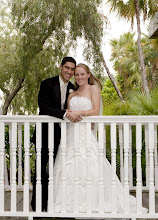Welcome to Part 2 of your online stringwork tutorials! To recap the
last lesson, you learned Basic Stringwork, which rests right against the side of the cake. The key was consistency in piping and loop length.
Today, we're jumping to one of the ADVANCED stringwork methods! These strings will come right off the side of the cake! They will be supported by what is called a "bridge", but they'll still be very fragile.
Step 1: Begin the Bridge
Pipe basic stringwork on your cake like you learned in the last lesson. Here, I've just shown 3 basic strings. But, be creative! You can do this all the way around your cake or in segments, with loops of the same size or different, sloping up and down the side of the cake or at the same level. The options are endless!
Let these strings dry for at least 10 minutes. If you're doing strings all the way around your cake, by the time you get back to the first few they should be dry enough to continue.
Step 2: Build Up the Bridge


Pipe more basic strings right onto the originals. The goal is to create a sugar shelf coming off of your cake horizontally. Try not to angle the shelf upwards or downwards - it just doesn't look as nice. After you pipe each string, wait for it to dry before adding more. If you add too many too quickly, the whole bridge will collapse. Try increasing or decreasing the length of the strings as you move away from the cake. Here, I'm decreasing the length so I'll have a convex shape against the side of the cake.
Some people like to use a damp paint brush to gently blend the strings as you pipe them. This creates a solid-looking bridge. However, others steadfastly believe that this method looks tacky! Try them both and decide for yourself. (I have not blended here, but have done it in the past.)
Step 3: Finish the Bridge



As a finishing touch on the bridge, I like to pipe one solid line all the way across the bridge. If you increase or decrease your string length as you moved away from the cake, this is especially important. Often when you change string lengths, the edges start to look messy. By piping a solid line all the way across, it makes the final bridge look much nicer and more professional! Can you see the difference between the bridges in this step and the ones in Step 2?
Let your bridge dry for several hours or overnight.
Step 4: Begin the Strings!

To begin the strings themselves, place your piping tip* against the side of the cake** and begin applying pressure to the piping bag.
*Here, I am using a tip 1. Stringwork can be done with many different sizes, but the smaller you go, the more delicate the strings look. Keep in mind that the smaller you go, the more difficult it gets too! A tip 1 or 2 is a good place to start if you're just learning.
Tips this small clog easily! First of all, always keep your tip covered with a damp cloth when you're not using it. This will prevent the royal icing from drying inside it. Second, I like to push all of my royal icing through clean, unused panty hose. It's a little messy, but the hose will catch all the large sugar crystals that will clog your tip while you're piping your strings. It's an extra little step that is MORE than worth it!
**I like to draw my stringwork pattern out on a piece of paper first. Then, I hold it up against the side of the cake (before I create the bridge) and use a straight pin to poke small holes in the fondant around the perimeter of my pattern. Don't go crazy with the hole punching, but you will never notice the small holes in the finished product if you pipe your strings right on the holes. Today, I am just designing the string pattern as I go, but I highly recommend planning yours ahead of time!

As you continue to apply pressure to the piping bag, slowly move away from the cake. Only the very beginning of the string should touch the cake. This part is a bit tricky to get the hang of. You have to move the piping tip fast enough away from the cake so that extra icing doesn't stick to the cake, but you have to move slow enough so that you don't break the icing string. Basically, the pressure you're squeezing the bag with (or the speed of the icing coming out of the tip) must match the speed of your tip moving away from the cake.

This is what happens if you move your tip away too quickly or if your icing is not the right consistency.
If your icing is too thin, it will not be strong enough to pipe in a long string. How do you recognize it? It will be very shiny and will stretch as you pipe the string.
If your icing is too thick, you will probably feel pain in your hand while you pipe. You will also probably break a lot of strings.
If your icing is not working, take the time to thin (add drops of water) or thicken (add powdered sugar) it. Imperfect icing consistency is a source of unnecessary frustration. Anyone can do stringwork if the consistency is correct! Just play with it and discover what you're comfortable with.

Ok, starting fresh again...hold the tip against the cake and begin to squeeze the bag while moving away from the cake.
Step 5: Hold the String

Pipe a string that you think is the appropriate length so that it will reach your bridge when you lower it. But don't lower it yet! Hold the string up with your tip just like I've shown in the photo above. Try to minimize wiggles, too. I like to rest my elbows against the table to keep me from shaking too much.
Why are you doing this? Holding the string up like this allows it to crust over a bit. If you were to immediately lower your string, it would probably slowly stretch and break due to gravity. Allowing it to dry a little makes it that much more resistant to gravity's detrimental effects.
This method will also get nicer strings, in my opinion. If you immediately lower the string to the bridge, it will droop a little. Conversely, if it's slightly crusted when you lower it, it will be straighter and seem to defy gravity even more!
The amount of time you hold the string depends on the length of the string. Shorter strings won't stretch as much due to gravity so they don't need to be held more than a couple of seconds. Long strings (2-3 inches long) will need to be held quite a bit longer. Sometimes, I count to 20 or 30 in my head. And this is something that seems to be highly effected by humidity levels! Again, you'll have to play with it to see what works for you each day.
Step 6: Lower the String



Slowly lower the end of the string until it touches the bridge. The dry bridge is relatively strong, but be gentle just in case.
Step 7: Finish the String

If the string hangs just below the bridge, use your piping tip or a paint brush to gently break away the extra icing.
Step 8: Add More Strings

Moving to the left and right of the original string, follow the steps above to create more! There are a few things to keep in mind in order to obtain really beautiful stringwork:
1. Place your strings so close together that you could not possibly put another string in between them.
2. Keep your strings perfectly vertical.
3. Keep your strings evenly spaced.
In the next couple of photos, I'll show the string steps above from another angle:




Notice the strings lying on the cake board? I call that the "string boneyard." The facts: You WILL break strings. You WILL lose some due to gravity and stretching. You WILL purposely break strings because the spacing is off or they are not perfectly vertical. Therefore, you WILL have your own string boneyard. It's ok! Let them dry and brush them away later.
Here are some photos of the finished strings from different angles:


 Step 9: Finishing Details
Step 9: Finishing DetailsNow, of course, you could stop there. The strings look pretty awesome, right? But now you need to make them your own! This is where a pre-planned design really comes in handy because if something doesn't look right, you've tried it in pencil and paper first...not on your time-consuming, perfect strings.


Bleh! See what I mean!? Yuck! Definitely design your ahead of time so this doesn't happen to you!
But anyway, you can add smaller loops, diagonal strings, basic strings, dots, etc. to your bridged strings. Try adding the details with a different color - they'll really pop!






































































